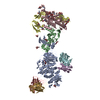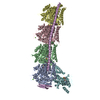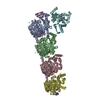[English] 日本語
 Yorodumi
Yorodumi- PDB-7lbf: CryoEM structure of the HCMV Trimer gHgLgO in complex with human ... -
+ Open data
Open data
- Basic information
Basic information
| Entry | Database: PDB / ID: 7lbf | ||||||
|---|---|---|---|---|---|---|---|
| Title | CryoEM structure of the HCMV Trimer gHgLgO in complex with human Platelet-derived growth factor receptor alpha and neutralizing fabs 13H11 and MSL-109 | ||||||
 Components Components |
| ||||||
 Keywords Keywords |  VIRAL PROTEIN/Immune System / VIRAL PROTEIN/Immune System /  virus / virus /  receptor / receptor /  complex / complex /  neutralizing antibody / neutralizing antibody /  VIRAL PROTEIN / VIRAL PROTEIN /  VIRAL PROTEIN-Immune System complex VIRAL PROTEIN-Immune System complex | ||||||
| Function / homology |  Function and homology information Function and homology informationplatelet-derived growth factor alpha-receptor activity / platelet-derived growth factor receptor-alpha signaling pathway / Imatinib-resistant PDGFR mutants / Sunitinib-resistant PDGFR mutants / Regorafenib-resistant PDGFR mutants / Sorafenib-resistant PDGFR mutants / PDGFR mutants bind TKIs / metanephric glomerular capillary formation / regulation of mesenchymal stem cell differentiation /  luteinization ...platelet-derived growth factor alpha-receptor activity / platelet-derived growth factor receptor-alpha signaling pathway / Imatinib-resistant PDGFR mutants / Sunitinib-resistant PDGFR mutants / Regorafenib-resistant PDGFR mutants / Sorafenib-resistant PDGFR mutants / PDGFR mutants bind TKIs / metanephric glomerular capillary formation / regulation of mesenchymal stem cell differentiation / luteinization ...platelet-derived growth factor alpha-receptor activity / platelet-derived growth factor receptor-alpha signaling pathway / Imatinib-resistant PDGFR mutants / Sunitinib-resistant PDGFR mutants / Regorafenib-resistant PDGFR mutants / Sorafenib-resistant PDGFR mutants / PDGFR mutants bind TKIs / metanephric glomerular capillary formation / regulation of mesenchymal stem cell differentiation /  luteinization / positive regulation of cell proliferation by VEGF-activated platelet derived growth factor receptor signaling pathway / luteinization / positive regulation of cell proliferation by VEGF-activated platelet derived growth factor receptor signaling pathway /  platelet-derived growth factor binding / retina vasculature development in camera-type eye / embryonic skeletal system morphogenesis / platelet-derived growth factor binding / retina vasculature development in camera-type eye / embryonic skeletal system morphogenesis /  vascular endothelial growth factor binding / cardiac myofibril assembly / embryonic digestive tract morphogenesis / vascular endothelial growth factor binding / cardiac myofibril assembly / embryonic digestive tract morphogenesis /  vascular endothelial growth factor receptor activity / Leydig cell differentiation / male genitalia development / cell activation / positive regulation of chemotaxis / signal transduction involved in regulation of gene expression / Signaling by PDGF / embryonic cranial skeleton morphogenesis / vascular endothelial growth factor receptor activity / Leydig cell differentiation / male genitalia development / cell activation / positive regulation of chemotaxis / signal transduction involved in regulation of gene expression / Signaling by PDGF / embryonic cranial skeleton morphogenesis /  platelet-derived growth factor receptor binding / face morphogenesis / estrogen metabolic process / adrenal gland development / roof of mouth development / odontogenesis of dentin-containing tooth / platelet-derived growth factor receptor binding / face morphogenesis / estrogen metabolic process / adrenal gland development / roof of mouth development / odontogenesis of dentin-containing tooth /  microvillus / negative regulation of platelet activation / platelet-derived growth factor receptor signaling pathway / white fat cell differentiation / hematopoietic progenitor cell differentiation / positive regulation of phospholipase C activity / positive regulation of calcium-mediated signaling / Signaling by PDGFRA transmembrane, juxtamembrane and kinase domain mutants / Signaling by PDGFRA extracellular domain mutants / microvillus / negative regulation of platelet activation / platelet-derived growth factor receptor signaling pathway / white fat cell differentiation / hematopoietic progenitor cell differentiation / positive regulation of phospholipase C activity / positive regulation of calcium-mediated signaling / Signaling by PDGFRA transmembrane, juxtamembrane and kinase domain mutants / Signaling by PDGFRA extracellular domain mutants /  transmembrane receptor protein tyrosine kinase activity / extracellular matrix organization / cell chemotaxis / Downstream signal transduction / host cell endosome membrane / HCMV Late Events / regulation of actin cytoskeleton organization / cellular response to amino acid stimulus / lung development / transmembrane receptor protein tyrosine kinase activity / extracellular matrix organization / cell chemotaxis / Downstream signal transduction / host cell endosome membrane / HCMV Late Events / regulation of actin cytoskeleton organization / cellular response to amino acid stimulus / lung development /  wound healing / wound healing /  cilium / cilium /  receptor protein-tyrosine kinase / receptor protein-tyrosine kinase /  platelet aggregation / cellular response to reactive oxygen species / HCMV Early Events / peptidyl-tyrosine phosphorylation / platelet aggregation / cellular response to reactive oxygen species / HCMV Early Events / peptidyl-tyrosine phosphorylation /  cell surface receptor protein tyrosine kinase signaling pathway / Constitutive Signaling by Aberrant PI3K in Cancer / positive regulation of fibroblast proliferation / PIP3 activates AKT signaling / cell surface receptor protein tyrosine kinase signaling pathway / Constitutive Signaling by Aberrant PI3K in Cancer / positive regulation of fibroblast proliferation / PIP3 activates AKT signaling /  cell junction / PI5P, PP2A and IER3 Regulate PI3K/AKT Signaling / host cell Golgi apparatus / RAF/MAP kinase cascade / in utero embryonic development / entry receptor-mediated virion attachment to host cell / protein autophosphorylation / positive regulation of ERK1 and ERK2 cascade / positive regulation of phosphatidylinositol 3-kinase/protein kinase B signal transduction / cell junction / PI5P, PP2A and IER3 Regulate PI3K/AKT Signaling / host cell Golgi apparatus / RAF/MAP kinase cascade / in utero embryonic development / entry receptor-mediated virion attachment to host cell / protein autophosphorylation / positive regulation of ERK1 and ERK2 cascade / positive regulation of phosphatidylinositol 3-kinase/protein kinase B signal transduction /  receptor complex / receptor complex /  protein kinase activity / positive regulation of cell migration / symbiont entry into host cell / fusion of virus membrane with host plasma membrane / external side of plasma membrane / protein kinase activity / positive regulation of cell migration / symbiont entry into host cell / fusion of virus membrane with host plasma membrane / external side of plasma membrane /  viral envelope / positive regulation of cell population proliferation / protein-containing complex binding / endoplasmic reticulum membrane / host cell plasma membrane / virion membrane / viral envelope / positive regulation of cell population proliferation / protein-containing complex binding / endoplasmic reticulum membrane / host cell plasma membrane / virion membrane /  Golgi apparatus / protein homodimerization activity / protein-containing complex / Golgi apparatus / protein homodimerization activity / protein-containing complex /  nucleoplasm / nucleoplasm /  ATP binding / ATP binding /  membrane / membrane /  nucleus / nucleus /  plasma membrane / plasma membrane /  cytoplasm cytoplasmSimilarity search - Function | ||||||
| Biological species |    Human cytomegalovirus Human cytomegalovirus  Homo sapiens (human) Homo sapiens (human) | ||||||
| Method |  ELECTRON MICROSCOPY / ELECTRON MICROSCOPY /  single particle reconstruction / single particle reconstruction /  cryo EM / Resolution: 2.8 Å cryo EM / Resolution: 2.8 Å | ||||||
 Authors Authors | Kschonsak, M. / Rouge, L. / Arthur, C.P. / Hoangdung, H. / Patel, N. / Kim, I. / Johnson, M. / Kraft, E. / Rohou, A.L. / Gill, A. ...Kschonsak, M. / Rouge, L. / Arthur, C.P. / Hoangdung, H. / Patel, N. / Kim, I. / Johnson, M. / Kraft, E. / Rohou, A.L. / Gill, A. / Martinez-Martin, N. / Payandeh, J. / Ciferri, C. | ||||||
 Citation Citation |  Journal: Cell / Year: 2021 Journal: Cell / Year: 2021Title: Structures of HCMV Trimer reveal the basis for receptor recognition and cell entry. Authors: Marc Kschonsak / Lionel Rougé / Christopher P Arthur / Ho Hoangdung / Nidhi Patel / Ingrid Kim / Matthew C Johnson / Edward Kraft / Alexis L Rohou / Avinash Gill / Nadia Martinez-Martin / ...Authors: Marc Kschonsak / Lionel Rougé / Christopher P Arthur / Ho Hoangdung / Nidhi Patel / Ingrid Kim / Matthew C Johnson / Edward Kraft / Alexis L Rohou / Avinash Gill / Nadia Martinez-Martin / Jian Payandeh / Claudio Ciferri /  Abstract: Human cytomegalovirus (HCMV) infects the majority of the human population and represents the leading viral cause of congenital birth defects. HCMV utilizes the glycoproteins gHgLgO (Trimer) to bind ...Human cytomegalovirus (HCMV) infects the majority of the human population and represents the leading viral cause of congenital birth defects. HCMV utilizes the glycoproteins gHgLgO (Trimer) to bind to platelet-derived growth factor receptor alpha (PDGFRα) and transforming growth factor beta receptor 3 (TGFβR3) to gain entry into multiple cell types. This complex is targeted by potent neutralizing antibodies and represents an important candidate for therapeutics against HCMV. Here, we determine three cryogenic electron microscopy (cryo-EM) structures of the trimer and the details of its interactions with four binding partners: the receptor proteins PDGFRα and TGFβR3 as well as two broadly neutralizing antibodies. Trimer binding to PDGFRα and TGFβR3 is mutually exclusive, suggesting that they function as independent entry receptors. In addition, Trimer-PDGFRα interaction has an inhibitory effect on PDGFRα signaling. Our results provide a framework for understanding HCMV receptor engagement, neutralization, and the development of anti-viral strategies against HCMV. | ||||||
| History |
|
- Structure visualization
Structure visualization
| Movie |
 Movie viewer Movie viewer |
|---|---|
| Structure viewer | Molecule:  Molmil Molmil Jmol/JSmol Jmol/JSmol |
- Downloads & links
Downloads & links
- Download
Download
| PDBx/mmCIF format |  7lbf.cif.gz 7lbf.cif.gz | 372.3 KB | Display |  PDBx/mmCIF format PDBx/mmCIF format |
|---|---|---|---|---|
| PDB format |  pdb7lbf.ent.gz pdb7lbf.ent.gz | 298.5 KB | Display |  PDB format PDB format |
| PDBx/mmJSON format |  7lbf.json.gz 7lbf.json.gz | Tree view |  PDBx/mmJSON format PDBx/mmJSON format | |
| Others |  Other downloads Other downloads |
-Validation report
| Arichive directory |  https://data.pdbj.org/pub/pdb/validation_reports/lb/7lbf https://data.pdbj.org/pub/pdb/validation_reports/lb/7lbf ftp://data.pdbj.org/pub/pdb/validation_reports/lb/7lbf ftp://data.pdbj.org/pub/pdb/validation_reports/lb/7lbf | HTTPS FTP |
|---|
-Related structure data
| Related structure data |  23253MC  7lbeC  7lbgC M: map data used to model this data C: citing same article ( |
|---|---|
| Similar structure data |
- Links
Links
- Assembly
Assembly
| Deposited unit | 
|
|---|---|
| 1 |
|
- Components
Components
-Envelope glycoprotein ... , 3 types, 3 molecules ABC
| #1: Protein | Mass: 87311.273 Da / Num. of mol.: 1 Source method: isolated from a genetically manipulated source Source: (gene. exp.)   Human cytomegalovirus (strain Merlin) / Strain: Merlin Human cytomegalovirus (strain Merlin) / Strain: Merlin / Gene: gH, UL75 / Cell line (production host): Expi293 / Production host: / Gene: gH, UL75 / Cell line (production host): Expi293 / Production host:   Homo sapiens (human) / References: UniProt: Q6SW67 Homo sapiens (human) / References: UniProt: Q6SW67 |
|---|---|
| #2: Protein | Mass: 30846.492 Da / Num. of mol.: 1 Source method: isolated from a genetically manipulated source Source: (gene. exp.)   Human cytomegalovirus (strain Merlin) / Strain: Merlin Human cytomegalovirus (strain Merlin) / Strain: Merlin / Gene: gL, UL115 / Cell line (production host): Expi293 / Production host: / Gene: gL, UL115 / Cell line (production host): Expi293 / Production host:   Homo sapiens (human) / References: UniProt: F5HCH8 Homo sapiens (human) / References: UniProt: F5HCH8 |
| #3: Protein | Mass: 58298.504 Da / Num. of mol.: 1 Source method: isolated from a genetically manipulated source Source: (gene. exp.)    Human cytomegalovirus / Gene: UL74 / Production host: Human cytomegalovirus / Gene: UL74 / Production host:   Homo sapiens (human) / References: UniProt: Q8BCU3 Homo sapiens (human) / References: UniProt: Q8BCU3 |
-Protein , 1 types, 1 molecules D
| #4: Protein | Mass: 59154.660 Da / Num. of mol.: 1 Source method: isolated from a genetically manipulated source Source: (gene. exp.)   Homo sapiens (human) / Gene: PDGFRA, PDGFR2, RHEPDGFRA / Production host: Homo sapiens (human) / Gene: PDGFRA, PDGFR2, RHEPDGFRA / Production host:   Homo sapiens (human) Homo sapiens (human)References: UniProt: P16234,  receptor protein-tyrosine kinase receptor protein-tyrosine kinase |
|---|
-Antibody , 4 types, 4 molecules EFGH
| #5: Antibody | Mass: 25780.020 Da / Num. of mol.: 1 Source method: isolated from a genetically manipulated source Source: (gene. exp.)   Homo sapiens (human) / Production host: Homo sapiens (human) / Production host:   Escherichia coli (E. coli) Escherichia coli (E. coli) |
|---|---|
| #6: Antibody | Mass: 26600.086 Da / Num. of mol.: 1 Source method: isolated from a genetically manipulated source Source: (gene. exp.)   Homo sapiens (human) / Production host: Homo sapiens (human) / Production host:   Escherichia coli (E. coli) Escherichia coli (E. coli) |
| #7: Antibody | Mass: 28355.809 Da / Num. of mol.: 1 Source method: isolated from a genetically manipulated source Source: (gene. exp.)   Homo sapiens (human) / Production host: Homo sapiens (human) / Production host:   Escherichia coli (E. coli) Escherichia coli (E. coli) |
| #8: Antibody | Mass: 27547.818 Da / Num. of mol.: 1 Source method: isolated from a genetically manipulated source Source: (gene. exp.)   Homo sapiens (human) / Production host: Homo sapiens (human) / Production host:   Escherichia coli (E. coli) Escherichia coli (E. coli) |
-Sugars , 3 types, 21 molecules 
| #9: Polysaccharide |  / Mass: 424.401 Da / Num. of mol.: 2 / Mass: 424.401 Da / Num. of mol.: 2Source method: isolated from a genetically manipulated source #10: Polysaccharide | alpha-D-mannopyranose-(1-2)-alpha-D-mannopyranose-(1-3)-[alpha-D-mannopyranose-(1-3)-alpha-D- ...alpha-D-mannopyranose-(1-2)-alpha-D-mannopyranose-(1-3)-[alpha-D-mannopyranose-(1-3)-alpha-D-mannopyranose-(1-6)]beta-D-mannopyranose-(1-4)-2-acetamido-2-deoxy-beta-D-glucopyranose-(1-4)-2-acetamido-2-deoxy-beta-D-glucopyranose |  / Mass: 1235.105 Da / Num. of mol.: 1 / Mass: 1235.105 Da / Num. of mol.: 1Source method: isolated from a genetically manipulated source #11: Sugar | ChemComp-NAG /  N-Acetylglucosamine N-Acetylglucosamine |
|---|
-Details
| Has ligand of interest | N |
|---|
-Experimental details
-Experiment
| Experiment | Method:  ELECTRON MICROSCOPY ELECTRON MICROSCOPY |
|---|---|
| EM experiment | Aggregation state: 2D ARRAY / 3D reconstruction method:  single particle reconstruction single particle reconstruction |
- Sample preparation
Sample preparation
| Component |
| ||||||||||||||||||||||||
|---|---|---|---|---|---|---|---|---|---|---|---|---|---|---|---|---|---|---|---|---|---|---|---|---|---|
| Molecular weight | Value: 0.335 MDa / Experimental value: NO | ||||||||||||||||||||||||
| Source (natural) |
| ||||||||||||||||||||||||
| Source (recombinant) |
| ||||||||||||||||||||||||
| Buffer solution | pH: 7.5 Details: The sample was gently cross-linked with 0.025% (v/v) EM-grade glutaraldehyde for 10 min at RT and quenched with 9 mM Tris pH 7.5 | ||||||||||||||||||||||||
| Buffer component |
| ||||||||||||||||||||||||
| Specimen | Conc.: 0.4 mg/ml / Embedding applied: NO / Shadowing applied: NO / Staining applied : NO / Vitrification applied : NO / Vitrification applied : YES / Details: This sample was monodisperse. : YES / Details: This sample was monodisperse. | ||||||||||||||||||||||||
| Specimen support | Details: The grid was coated with Au/Pd 80/20 prior use. / Grid mesh size: 300 divisions/in. / Grid type: C-flat-1.2/1.3 | ||||||||||||||||||||||||
Vitrification | Instrument: FEI VITROBOT MARK IV / Cryogen name: ETHANE / Humidity: 100 % / Chamber temperature: 277 K / Details: blot for 2.5 seconds before plunging |
- Electron microscopy imaging
Electron microscopy imaging
| Experimental equipment |  Model: Titan Krios / Image courtesy: FEI Company |
|---|---|
| Microscopy | Model: FEI TITAN KRIOS |
| Electron gun | Electron source : :  FIELD EMISSION GUN / Accelerating voltage: 300 kV / Illumination mode: FLOOD BEAM FIELD EMISSION GUN / Accelerating voltage: 300 kV / Illumination mode: FLOOD BEAM |
| Electron lens | Mode: BRIGHT FIELD Bright-field microscopy / Nominal magnification: 165000 X / Cs Bright-field microscopy / Nominal magnification: 165000 X / Cs : 2.7 mm : 2.7 mm |
| Specimen holder | Cryogen: NITROGEN / Specimen holder model: FEI TITAN KRIOS AUTOGRID HOLDER |
| Image recording | Average exposure time: 10 sec. / Electron dose: 50 e/Å2 / Film or detector model: GATAN K2 SUMMIT (4k x 4k) / Num. of grids imaged: 2 / Num. of real images: 34829 / Details: Images were collected in 50 frames every 0.2 s |
| Image scans | Movie frames/image: 50 |
- Processing
Processing
| EM software |
| ||||||||||||||||||||||||||||||||||||||||||||||||||||||||||||
|---|---|---|---|---|---|---|---|---|---|---|---|---|---|---|---|---|---|---|---|---|---|---|---|---|---|---|---|---|---|---|---|---|---|---|---|---|---|---|---|---|---|---|---|---|---|---|---|---|---|---|---|---|---|---|---|---|---|---|---|---|---|
CTF correction | Type: PHASE FLIPPING AND AMPLITUDE CORRECTION | ||||||||||||||||||||||||||||||||||||||||||||||||||||||||||||
| Particle selection | Num. of particles selected: 4151085 | ||||||||||||||||||||||||||||||||||||||||||||||||||||||||||||
| Symmetry | Point symmetry : C1 (asymmetric) : C1 (asymmetric) | ||||||||||||||||||||||||||||||||||||||||||||||||||||||||||||
3D reconstruction | Resolution: 2.8 Å / Resolution method: FSC 0.143 CUT-OFF / Num. of particles: 3560620 Details: Used score threshold of 0.25 for final 3D reconstruction. Map used for model refinements is a composite map after combining 3 focussed maps with PHENIX Symmetry type: POINT | ||||||||||||||||||||||||||||||||||||||||||||||||||||||||||||
| Atomic model building | Protocol: AB INITIO MODEL / Space: REAL |
 Movie
Movie Controller
Controller














 PDBj
PDBj












